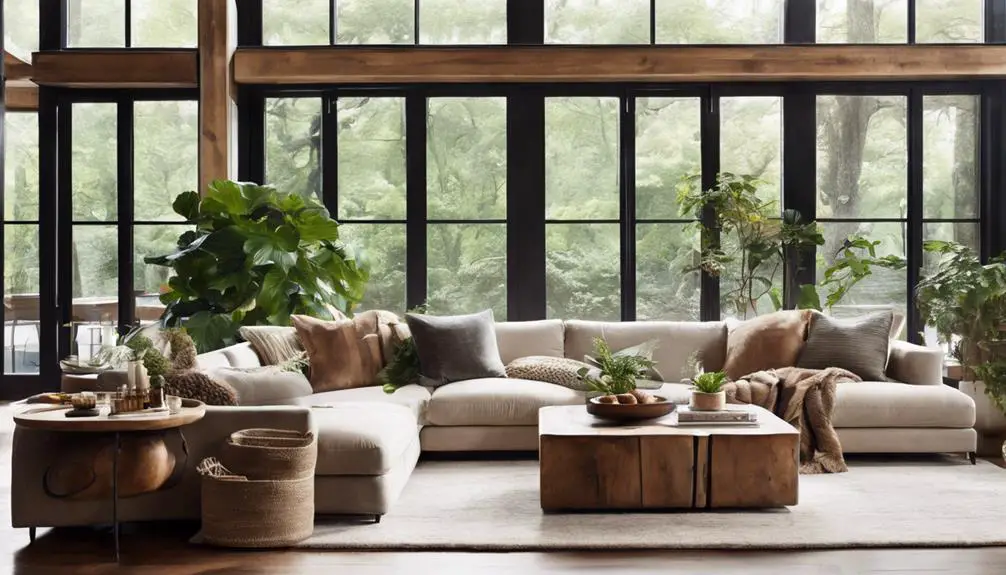As you envision your ideal living room, you're likely thinking about more than just a beautiful space – you want a functional haven that reflects your personality. You're pondering how to balance style with comfort, and functionality with aesthetics. You're thinking about how to create a room that's perfect for relaxation, entertainment, and everyday living. But where do you start? With so many elements to weigh, from floor plans to lighting schemes, it can be overwhelming. Let's break it down and explore the essentials for crafting a living room that truly feels like home.
Cozy Reading Nook Essentials
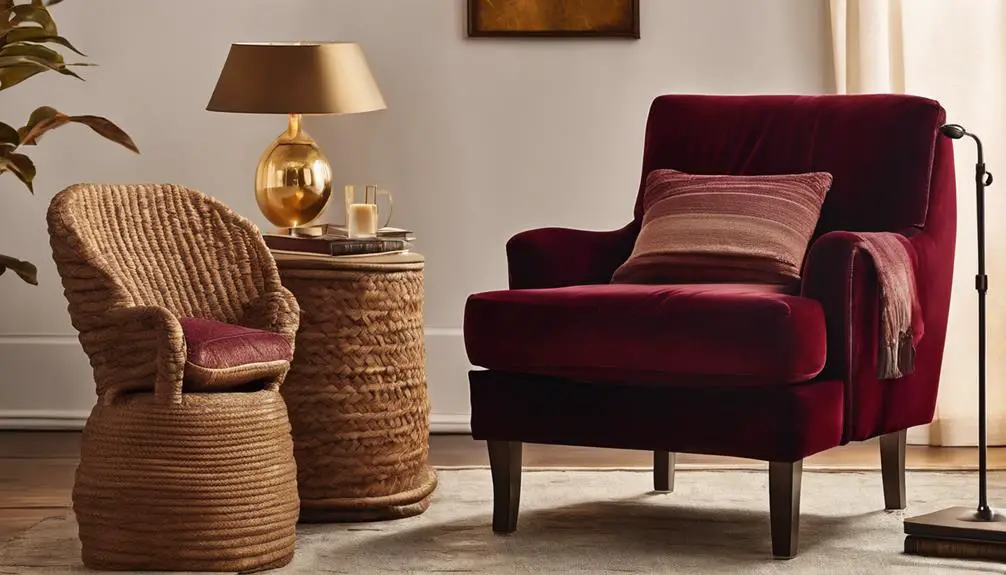
As you carve out a cozy reading nook, envision a serene retreat that invites relaxation and fosters a deep connection with the pages of your favorite book.
This intimate space should be tailored to your personal taste, with plush, cozy pillows in soft, calming hues that cradle your body as you read.
To create a visually appealing and functional nook, consider incorporating floor-to-ceiling bookshelves that stretch towards the ceiling, filled with your favorite novels, classics, and coffee table books.
The vertical element will draw the eye upwards, creating a sense of airiness and openness.
Choose a comfortable, oversized armchair or a plush ottoman to anchor the space, and add a side table or stool to hold your reading materials and a warm cup of coffee or tea.
As you settle into your cozy reading nook, feel the stresses of the day melt away, and let the words on the page transport you to a world of wonder and imagination.
Sectional Sofa Layout Ideas
As you plan your sectional sofa layout, consider placing the sofa against the wall to create a clean line of sight and define the seating area.
Alternatively, you can opt for a floating sectional design, which allows for more flexibility and creates a sense of flow in the room.
Sofa Against The Wall
The sofa against the wall layout is a classic choice for many living rooms, and for good reason: it creates a sense of openness and flow, making the space feel more expansive.
By placing your sectional sofa against a wall, you're creating a clear pathway through the room, allowing for effortless circulation and conversation. This layout also enables you to showcase stunning wall decor, such as a statement piece of art or a floor-to-ceiling mirror, which can add depth and visual interest to the space.
To maximize room flow, consider placing a console table or narrow console behind the sofa, creating a subtle divide between the seating area and the rest of the room.
This will also provide a convenient spot to display decorative items or serve as a makeshift bar. Additionally, choose a wall color that complements your sofa's hue to create a sense of harmony and balance.
Floating Sectional Design
With a floating sectional design, you can create a dynamic, conversational atmosphere in your living room by placing your sectional sofa away from the walls.
This layout allows for a more open and airy feel, perfect for modern minimalism enthusiasts. By floating your sectional, you can define different areas within the room, creating a sense of flow and visual interest.
For instance, you can place a console table or floating shelves behind the sofa to create a cozy reading nook or add a floor lamp to create ambiance.
To take full advantage of this design, consider the room's traffic flow and create a pathway around the sectional.
This will encourage conversation and movement throughout the space. You can also use the floating sectional to create a sense of separation between different areas of the room, such as a TV zone and a reading area.
With a little creativity, a floating sectional design can transform your living room into a functional and stylish space that's perfect for relaxation and socializing.
Accent Wall Inspiration

A few strategically placed accent walls can elevate your living room from ordinary to extraordinary.
By incorporating a statement wall, you'll create a visually appealing focal point that draws the eye and adds depth to the space.
To get started, consider the colors you want to feature. Accent colors can be bold and bright, or soft and subtle, depending on your personal style.
You can also use wall art to add texture and interest to the space. Think beyond traditional rectangular artwork and explore unique shapes and sizes to add visual appeal.
A geometric pattern or abstract design can create a stunning accent wall that becomes a conversation starter.
If you're feeling adventurous, try a mural or oversized graphic to make a bold statement.
Whatever your style, an accent wall is an easy way to inject personality into your living room and create a space that truly reflects your design aesthetic.
Creating a Functional Floor Plan
You'll want to design a floor plan that accommodates three essential elements: a zone for conversation, where you'll place furniture to encourage socializing; a path for circulation, ensuring easy movement throughout the room; and space for storage, cleverly incorporating shelves, cabinets, or other solutions to keep clutter at bay.
Zone for Conversation
The furniture arrangement in your living room sets the stage for meaningful interactions.
When designing a zone for conversation, consider the social circle you want to create. A well-placed seating arrangement can foster connections and spark conversations. Position your furniture to encourage face-to-face interactions, with a clear line of sight between each seat.
This will help create a sense of togetherness and facilitate meaningful discussions.
Use conversation starters like statement pieces, such as a bold art piece or an eye-catching rug, to draw people in and create a sense of curiosity.
Consider the scale of your furniture and the negative space around it to create a comfortable and inviting atmosphere. Avoid clutter and keep the area tidy to promote relaxation and focus on the conversation.
Path for Circulation
Circulation paths guide the flow of people through your living room, allowing them to move effortlessly between different zones.
When designing your traffic flow, consider the primary entrance and exit points, as well as the routes people will take to reach different areas of the room.
A well-planned circulation path guarantees that your space feels open and uncluttered, even when multiple people are moving around.
To optimize your circulation paths, create a clear route through the room, avoiding narrow walkways and tight corners.
You can achieve this by positioning furniture in a way that creates a natural flow, such as placing a console table behind a sofa or using a circular coffee table to guide traffic around the seating area.
Additionally, consider the "work triangle" concept, where you position key elements like the TV, seating, and coffee table in a triangular formation to facilitate easy movement between them.
Space for Storage
Five essential areas in your living room demand ample storage: the TV and media zone, reading nook, coffee table, console table, and seating area.
Each of these zones requires clever storage solutions to keep your living room organized and clutter-free.
In the TV and media zone, consider installing hidden compartments behind a sliding panel or a lift-top coffee table to stash away DVDs, gaming consoles, and other media devices.
In the reading nook, opt for a storage ottoman or a side table with built-in shelves to store books, magazines, and reading accessories.
For the coffee table, look for one with built-in storage, such as a lift-top or a hollowed-out center for storing items like coasters, napkins, and remote controls.
The console table can be fitted with decorative baskets or bins to store mail, keys, and other small items.
Finally, in the seating area, incorporate storage into your furniture, such as a storage sectional sofa or an armchair with a hidden compartment.
Mixing Pattern and Texture
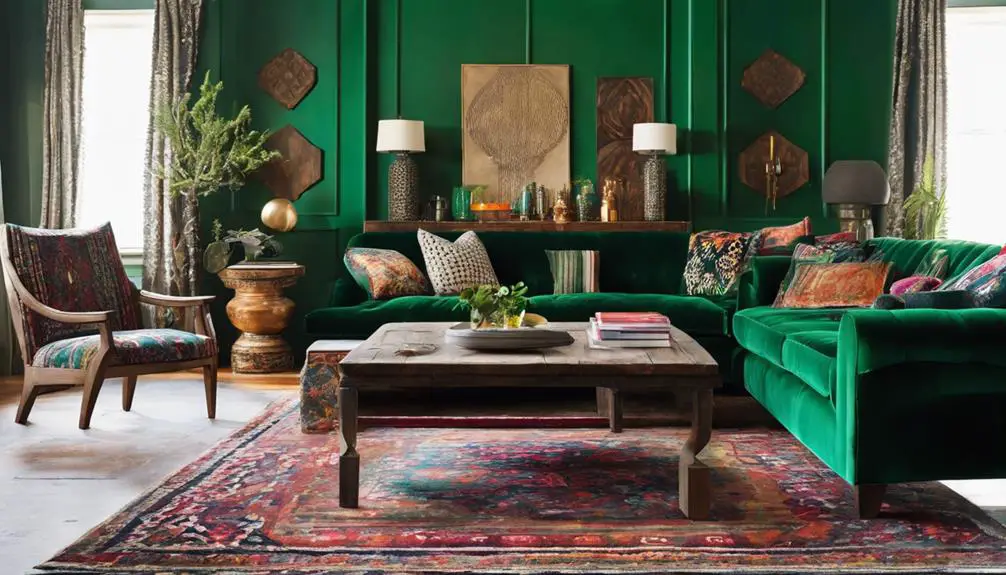
As you step into a well-designed living room, your eyes are instantly drawn to the harmonious blend of patterns and textures that create a rich, visually appealing atmosphere.
This masterful mix of Pattern Play and Texture Mix is what sets a stylish space apart from a bland one.
To achieve this look, start by selecting a few statement pieces with bold patterns, such as a geometric-print rug or a vibrant abstract art piece.
Then, balance these bold elements with more subdued textures like smooth leather or plush velvet.
Don't be afraid to experiment with different scales and styles – a large, chunky throw blanket can add depth to a sleek, low-profile sofa.
Remember, the key to successful Pattern Play is to create visual interest without overwhelming the senses.
TV Stand and Media Center
Step into a thoughtfully designed living room, and you're immediately drawn to the TV stand and media center, the hub of entertainment and relaxation.
This focal point demands attention, and modern designs are elevating the game. You'll find sleek, low-profile TV stands that appear to float, creating a sense of airiness in the room.
Others feature hidden compartments, cleverly concealing cables, DVDs, and gaming consoles from view. This clever use of space keeps the area organized and visually appealing.
Consider a TV stand with a built-in soundbar or a media center with a slide-out keyboard tray. These innovative features streamline your entertainment experience, freeing up floor space and minimizing clutter.
Look for materials like reclaimed wood, glass, or metal to add depth and visual interest to the area. A well-designed TV stand and media center can become a stunning centerpiece in your living room, perfect for cozying up to watch your favorite shows or hosting game nights with friends.
Rug Size and Placement Guide
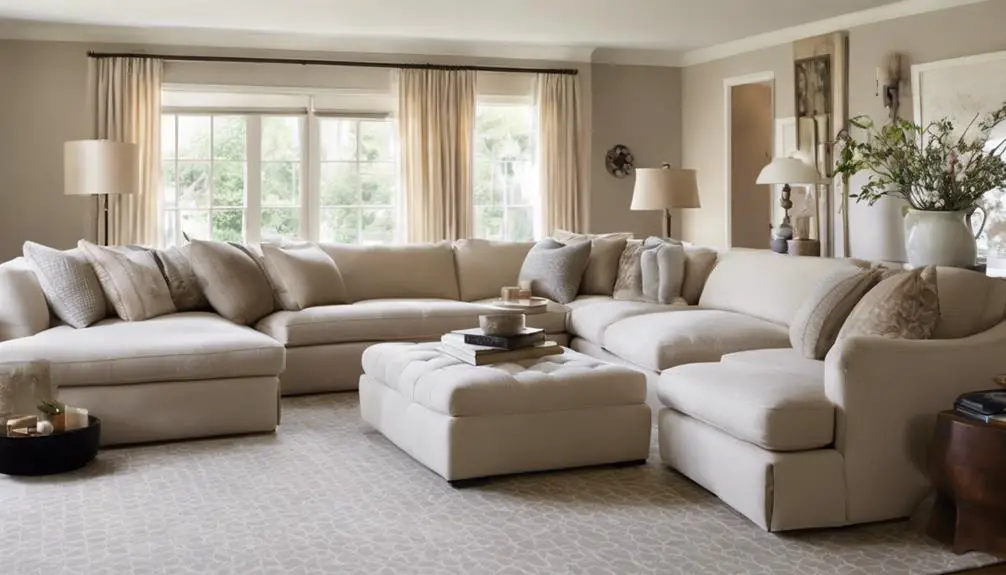
When choosing a rug, you're not just selecting a color or pattern – you're determining the anchor of your living room's layout.
To guarantee a harmonious space, you'll want to follow rug proportion rules, such as scaling the rug to the room's dimensions and balancing it with furniture.
Rug Proportion Rules
While envisioning your ideal living room, you've likely spent hours selecting the perfect furniture, paint colors, and decorative accents, but have you given equal consideration to the rug that will tie it all together?
A well-proportioned rug can make or break the room's flow and aesthetic. To guarantee your rug is the perfect anchor, consider the following proportion rules.
For a cohesive look, choose a rug that's proportional to your furniture.
A general rule of thumb is to select a rug that's large enough to fit under the front legs of your furniture, but not so large that it overwhelms the space. For example, if you have a sectional sofa, opt for a rug that fits under the front legs of the entire piece. This creates a sense of unity and flow.
When it comes to rug styles, consider the room's architecture and design.
For instance, a modern room with clean lines and minimal ornamentation pairs well with a sleek, low-pile rug. On the other hand, a traditional or eclectic space can handle a more ornate, plush rug.
Rug Placement Options
By carefully positioning your rug, you can create a sense of balance and harmony in your living room.
When deciding on rug placement options, consider the room's layout and traffic flow.
For a symmetrical look, place the rug under the coffee table or centered in the room.
For an asymmetrical look, position the rug under a section of the seating arrangement or near a focal point, like a fireplace.
Consider the rug styles and materials when choosing a placement option.
For example, a natural fiber rug like sisal or jute works well under a rustic or coastal-inspired seating arrangement.
A plush rug in a bold color or pattern can add visual interest under a modern or eclectic seating arrangement.
Experiment with different rug placement options to find the one that works best for your living room.
Try placing the rug at an angle or partially under the furniture to create a sense of movement and energy.
Ultimately, the key is to find a placement that creates a sense of balance and harmony, while also reflecting your personal style and design aesthetic.
Built-in Shelving and Storage
As you envision your ideal living room, consider the impact built-in shelving and storage can have on the overall aesthetic and functionality of the space.
By incorporating custom shelving styles, you can create a cohesive look that complements your furniture and decor. For instance, floor-to-ceiling shelves can make a statement and provide ample storage for books, decorative items, and other knick-knacks.
When it comes to storage solutions, built-in cabinetry can be a game-changer.
Not only does it keep clutter at bay, but it also creates a sleek, streamlined look. Consider installing sliding glass doors or drawers to add an extra layer of sophistication.
Additionally, built-in banquettes with storage can provide a cozy nook for reading or relaxation while keeping items like throw blankets and pillows within easy reach.
Small Space Living Room Solutions
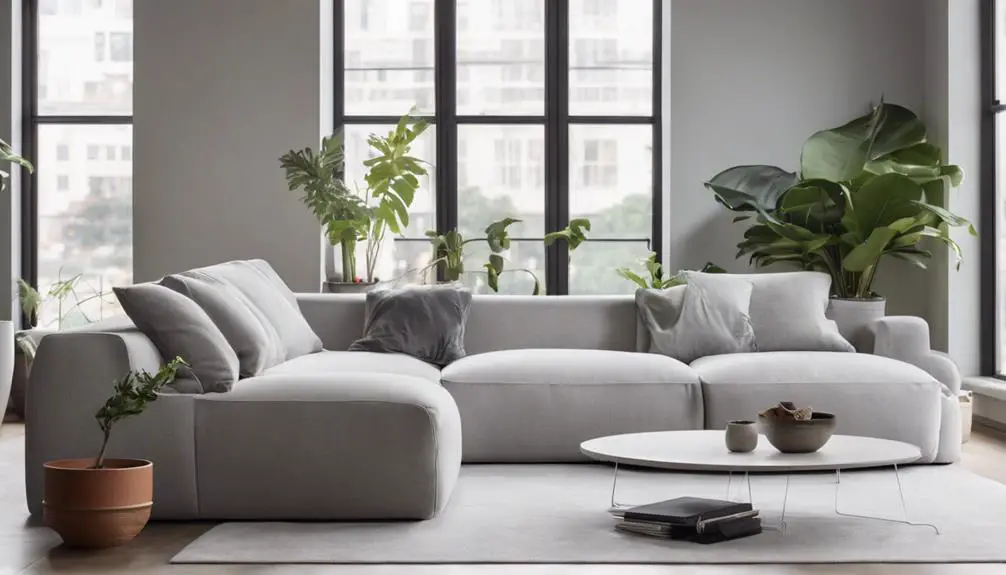
In compact living rooms, every inch counts, and clever design strategies can make a significant difference.
You'll want to focus on space planning to maximize the functionality of your room. Start by mapping out the floor plan, considering the traffic flow and identifying areas where you can create zones for relaxation, entertainment, and conversation.
Select small decor pieces that serve multiple purposes, such as a storage ottoman or a console table with built-in shelves.
These space-saving solutions will help maintain a sense of openness while keeping clutter at bay. Consider vertical elements like floor lamps or tall vases to draw the eye upward, creating the illusion of higher ceilings.
When choosing furniture, opt for sleek, low-profile pieces that won't visually clutter the space.
A sleek sectional sofa or a minimalist coffee table can help create a sense of breathability. Don't be afraid to edit your decor – a few carefully curated pieces will make a greater impact than a crowded, busy space.
Color Scheme and Palette Options
With your compact living room's layout and furniture carefully considered, it's time to bring the space to life with a thoughtful color scheme and palette.
You'll want to choose a palette that complements the room's dimensions, natural light, and furniture. Consider a monochromatic harmony, where different shades of the same color create a cohesive look. This approach can make the room feel more spacious and visually appealing.
To add some visual interest, try color blocking, where you divide the room into sections using different colors.
This technique can create a sense of depth and energy in the space. When selecting colors, think about the mood you want to create. Cool tones like blues and greens can create a calming atmosphere, while warm tones like oranges and yellows can stimulate conversation.
Don't be afraid to experiment and have fun with the process. Remember, the right color scheme can elevate your compact living room from functional to fabulous.
Adding Plants and Greenery
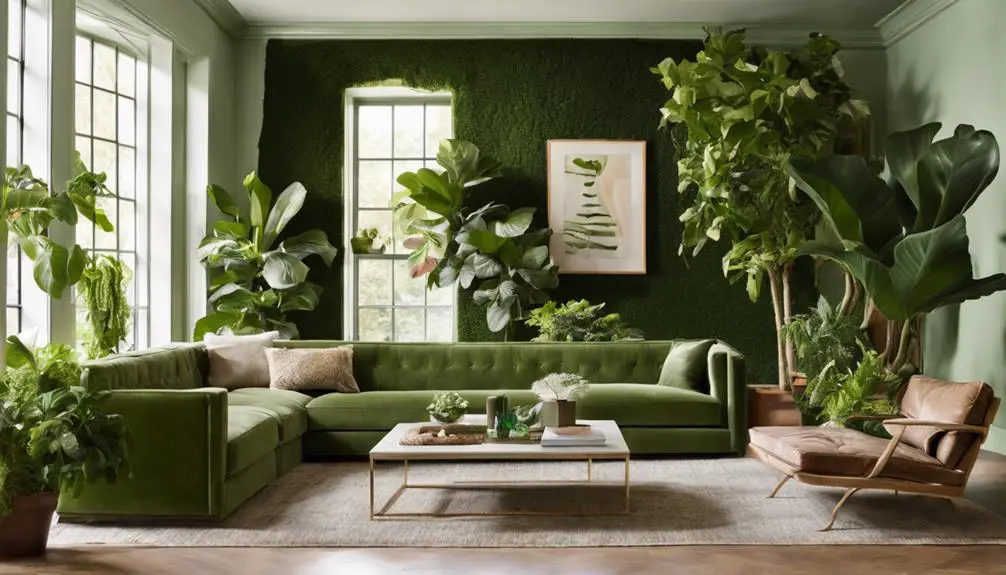
Bringinging life to your compact living room, lush plants and greenery can transform the space, softening angular lines and adding organic texture.
With the right selection, you can turn your room into an urban jungle, teeming with freshness and vibrancy.
Start by choosing plants with varying textures, like velvety leaves or prickly stems, to add depth and visual interest.
Fresh greens like ferns, peace lilies, or snake plants are great options, as they're low-maintenance and can thrive in low-light conditions.
Consider grouping plants together to create a lush, verdant corner or placing them on shelves to create a stunning vertical display.
Don't be afraid to experiment with unique planters or pots that add a pop of color or whimsy to the space.
Ambient and Task Lighting Ideas
Soft, warm glows and focused beams of light can drastically alter the ambiance of your compact living room, making it feel cozier, more inviting, and even larger.
By incorporating ambient and task lighting, you can create a layered lighting scheme that caters to different activities and moods.
Start by selecting table lamps with sculptural shapes and unique materials, such as metal or glass, to add visual interest to your space. These fixtures can provide soft, warm pools of light that create a cozy atmosphere.
For task-oriented areas, like reading nooks or workstations, use floor fixtures with adjustable arms to direct focused beams of light exactly where you need them.
Consider fixtures with sleek, minimalist designs to maintain a sense of openness in your compact living room.
Frequently Asked Questions
How Do I Choose the Right Ceiling Fan for My Living Room?
When selecting a ceiling fan, you'll want to ponder the room's dimensions and ceiling style; measure the space to determine the ideal fan size, and choose a design that complements your ceiling's slope, height, and architectural style.
What Is the Ideal Room Temperature for a Cozy Living Space?
You set your Winter thermostat to 68°F, ensuring a cozy ambiance, and boost it to 78°F in Summer for comfort; this ideal temperature range creates a perfect blend of warmth and refreshment, making your space inviting and relaxing.
Can I Use a Living Room as a Home Office and Make It Functional?
You can create a productive home workstation by incorporating flexible seating, like a swivel chair or a convertible sofa, and cleverly designed storage solutions, allowing you to seamlessly shift between work and relaxation modes.
How Often Should I Clean and Maintain My Living Room Furniture?
You should clean and maintain your furniture regularly, ideally every 1-2 weeks, using furniture polish to protect surfaces and upholstery cleaning for stains, ensuring a pristine space that exudes sophistication and functionality.
Are There Specific Living Room Design Rules for Pet Owners?
As a pet owner, you'll want to ponder pet-friendly fabrics that repel stains and odors, and incorporate stain concealers into your design plan, ensuring a beautiful, functional space that accommodates your furry friends' accidents and mishaps.
Conclusion
You've curated a stunning living room that exudes warmth and style. Every element, from the cozy reading nook to the bold accent wall, works in harmony to create a space that's both functional and beautiful. With a thoughtful floor plan, mixed patterns and textures, and a layered lighting scheme, you've crafted an atmosphere that's inviting and relaxing. Now, sit back, unwind, and enjoy the fruits of your design labor!
